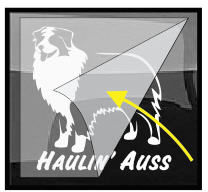Vinyl Decal ~ add text or leave blank, choose size and color.
NickerStickers Decals are Easy to Apply!Whether you've never, ever applied a decal before or are an old pro, NickerStickers go on smooth and easy and stick very well.
Before you start, WASH THE SURFACE!
Don't Use Window Cleaner!
We recommend you use plain old soap and water, 1/3 cup soap to 1 cup water. If there is any wax build up, use a scrubby. Finish with a lint free cloth to dry. You can add additional touch of extra cleaning with rubbing alcohol, mixed half and half with water. But soap and water is usually good enough.
Step 1. Peel the transfer tape with the decal stuck to it away from the waxy backing paper. The adhesive side of your decal is now exposed. Be careful! Don't get it dirty and don't touch it with your fingers. Use the clear transfer tape to hold because you'll be taking that off later anyway. 
Step 2. Using the transfer tape, roll your decal on to the surface to which you are applying, starting at one corner and laying it down. Once it is on the surface, rub on top of the clear transfer tape and decal using a credit card and working from the center out. Press lightly at first, then repeat more firmly. Repeat several times. 
Step 3. REMOVE THE TRANSFER TAPE. The decal is under the transfer tape. Pull the transfer tape up at a sharp angle beginning at one corner. Remove the clear tape on top of the decal and throw it away. Your decal should easily stick to the surface while you are pulling up the transfer tape. If it's not sticking solid, try leaving it on overnight and taking it off the next day. 
For more information on decal application, including applying large decals,
video instruction, and trouble shooting, click here:

The Standardbred horse is best known for its ability to race in harness at a trot or pace instead of under saddle at a gallop, but they are also an outstanding pleasure horse as being very good at many other equestrian activities. They are very good jumpers. The Standardbred is considered a people-oriented, easy-to-train horse. The Standardbred is prized by the Amish as an excellent buggy horse.
Breeds that have contributed foundation stock to the Standardbred breed included the Narragansett Pacer, Canadian Pacer,Thoroughbred, Norfolk Trotter, Hackney, and Morgan. Breeders selected bloodlines that would produce the fastest horses, with one of the most notable sires being the gray Thoroughbred stallion Messenger, which was exported to the United States in 1788. Messenger was bred to race on flat, but like many of the early Thoroughbreds, had Norfolk Roadster blood in his pedigree. He was mated to many Thoroughbred mares, and was soon found to have the ability to produce good trotting horses. Messenger's descendant, the legendary Hambletonian 10, also known as Rysdyk's Hambletonian, was born in 1849. He was sold, his owners thinking he was worthless, but later became one of the most prolific sires of Standardbreds, today with nearly every trotter or pacer tracing its lineage back to him. Today's Standardbred still has some characteristics familiar to the Thoroughbred, but the Standardbred is generally a bit heavier in build with refined, solid legs and powerful shoulders and hindquarters. Standardbreds have a wide range of heights, from 14 to 17 hands, although most are between 15 and 16 hands.
The name "Standardbred" was first used officially in 1879, because, to be registered, every Standardbred had to be able to trot a mile within the "standard" of two minutes and 30 seconds. Today, many Standardbreds race much faster than this original standard, with several pacing the mile within 1 min, 50 sec, and trotters are only a few seconds slower than pacers.
We here at NickerStickers are honored when anyone chooses our Standardbred horse decal and stickers designs to represent this fine breed.
|